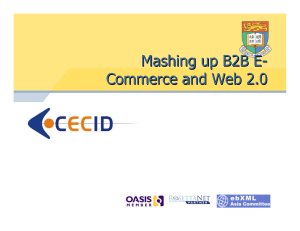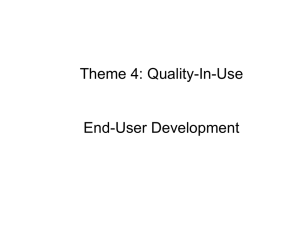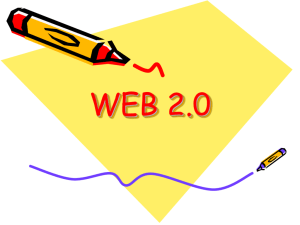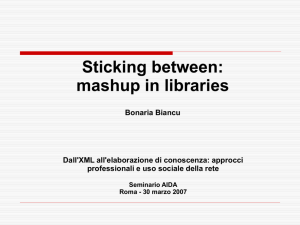Web 2.0 for the Adaptive Web Alexandra Cristea
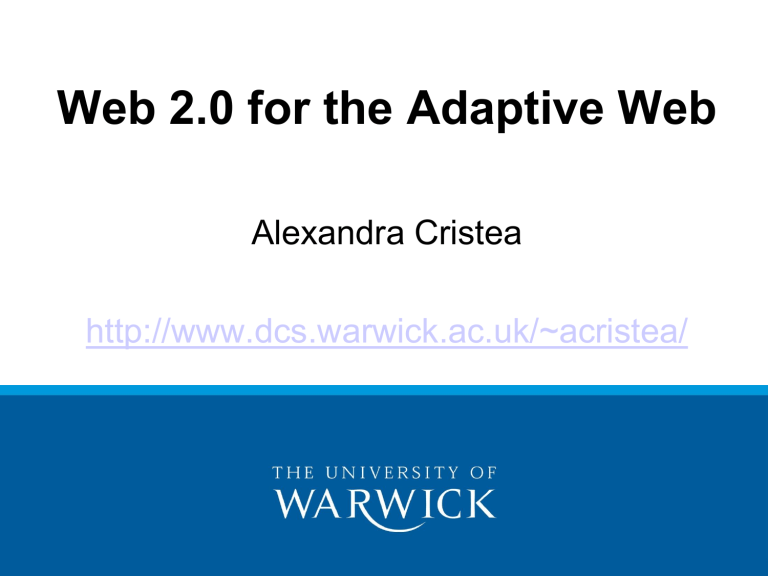
Web 2.0 for the Adaptive Web
Alexandra Cristea http://www.dcs.warwick.ac.uk/~acristea/
Overview
• Web 2.0
– versus Web 1.0
– Applications
– Mashups
– Concepts
– Market
– Trends (social, business, technology)
2
3
3
Web 2.0:
Evolution Towards a Read/Write Platform
Web 1.0
(1993-2003)
Pretty much HTML pages viewed through a browser
“Read”
“Page”
“static”
Web browser
“Client Server”
Web Coders
“geeks”
Web 2.0
(2003- beyond)
Web pages, plus a lot of other “content” shared over the web, with more interactivity; more like an application than a
“page”
“Write” & Contribute Mode
Primary Unit of content
State
“Post / record”
Viewed through… Browsers, RSS Readers, anything
Architecture
Content Created by…
Domain of…
“dynamic”
“Web Services”
Everyone
4
“mass amateurization”
Cuene.com/mima
Web 2.0 is the network as platform , spanning all connected devices; Web 2.0 applications are those that make the most of the intrinsic advantages of that platform: delivering software as a continually-updated service that gets better the more people use it, consuming and remixing data from multiple sources, including individual users, while providing their own data and services in a form that allows remixing by others, creating network effects through an " architecture of participation ," and going beyond the page metaphor of Web 1.0 to deliver rich user experiences .
Tim O'Reilly, “
Web 2.0: Compact Definition?
”
5
Web 2.0:
Is it a Whole New Internet?
6
It’s Hard to Define, But I Know it When I See it…
Emerging
Tech
• Web Services / API’s
• “Folksonomies” / Content tagging
• “AJAX”
• RSS
"[This is] not my mom's
Internet …It's changing, and it's changing because we're looking at the share-
Apps You
May
Know…
• Flickr
• Google Maps
• Blogging & Content Syndication
• Craigslist
• Linkedin, Tribes, Ryze, Friendster shifting—the time people are looking at TV, reading a magazine, listening to the radio—they're not replacing each other; they're coming together." AOL Exec / May
Some
Apps You
May NOT know
• Del.icio.us
• Upcoming.org
• 43Things.com
2005
Major
Retailers
• Amazon API’s
• Google Adsense API
• Yahoo API
• Ebay API
7
8
9
10
11
Dion Hinchliffe, “ Review of the Year's Best Web 2.0 Explanations ”
Web 2.0 Journal
Web 2.0 Applications
12
Flickr is a social network for sharing photos.
Flickr combines social network w user generated content.
Users work together, collaborate on photo projects & use each others’ tags to find new photos. Flickr has an API for web services to integrate photo collections w blogs & other apps.
My contacts “tags” are available to me
Cuene.com/mima
Flickr shows me photos from my network
13
Del.icio.us was an Example of a Site that Uses a “Folksonomy” to Organize Bookmarks
A “folksonomy” is a spontaneous, collaborative work to categorize links by a community of users. Users take control of organize the content together.
Tags: Descriptive words applied by
My Tags: Words I’ve used to describe links users to links. Tags in a way that makes are searchable sense to me
Cuene.com/mima
14
Wikipedia is a Collaborative Dictionary
Being Edited in Realtime by Anyone
Cuene.com/mima
15
Blogging is the Most Recognized Example of
Web 2.0
Cuene.com/mima
16
Chicago Crimes – Daily Crime Data on top of Google
Maps, sent to you by RSS
Cuene.com/mima 17
Social Networks Connect Users into
Communities of Trust (or interests)
Cuene.com/mima 18
A new way of receiving content…
19
Cuene.com/mima
How You Do It: Example CNN Interactive
20
Cuene.com/mima
RSS Reader Examples
21
Cuene.com/mima
22
22
Mashups
• What it is?
• Example mashups
• Example mashups based on Web 2.0 applications
23
What is Mashup?
• A mashup is a web page or application that combines data or functionality from two or more external sources to create a new service. - Wikipedia
24
Mashup genres
• Mapping mashups
• Video and photo mashups
• News mashups
• Search and Shopping mashups
• etc.
25
Examples of Mashup
• http://trendsmap.com/ (trends in Twitter topics: mash Google maps + Twitter)
• http://www.liveplasma.com/ (visual search engine for movies, artists etc.: mash Amazon
API)
• Seee more at: http://mashable.com/2009/10/08/topmashups/#2eV2Zdk2JPqd
26
27
28
29
MAP API
EVENTS API
IMAGE
API
30
Web 2.0 Concepts
• User generated content
• Various user types and roles
• Collaborative creation and sharing
• Bottom-up versus top-down approaches
• Emerging groups and communities
• Cloud tag
• Mashups
• Blogs & micro-blogs
31
• Last time:
– Basics of Web 2.0, definitions (incl. O’Reilly); concepts;
– Web 1.0 versus Web 2.0
– Mashups, micro-, macro-blogs;
– Semantic web versus Web 2.0
• Next:
– 7 O’Reilly principles; 3 aspects of Web 2.0 collaboration; Tactical Opportunities for Early
Adopters & Marketers; Web 2.0 pie chart; AJAX,
Web 2.0 meme map; open issues;
32
The 7 O’Reilly principles
1. The Web As A Platform
2. Harnessing Collective Intelligence
3. Data Is The Next “Intel Inside”
4. End of the Software Release Cycle
5. Lightweight Programming Models
6. Software Above the Level of a Single Device
7. Rich User Experiences
REST, APIs,
Mashups f o r e v e r
33
Web 2.0 and businesses
34
The 3 aspects of Web 2.0 Collaboration
Internal Collaboration B2B Collaboration
Internal Blogging
Mashups
Internal Wikis
Enterprise Social Bookmarking
Complementary Web Services
Open Standards
Social Tagging
Enterprise Social Networking
C2C2B Collaboration
User Created Content
User Communities
Viral Marketing
35
Source: Gartner Says Web 2.0 Offers Many Opportunities for Growth, But Few Enterprises Will
Immediately Adopt All Aspects Necessary for Significant Business Impact , May 2006
Ian McNairn – Program Director Web Innovation – Office of the CIO, IBM
Users Who Are Using Web 2.0 Apps are Highly Engaged,
Active and Attractive to Marketers
Blogging is a good proxy for web 2.0 activities.
Blog readers consume a
LOT of media
Cuene.com/mima
36
Users Find Blog Content Helpful, and They Are
Receptive to Online Ads
Cuene.com/mima 37
Web 2.0 means changes for marketers
• More users are connecting to each other and content through networked, peer-driven activities & content
– Linkedin now has service referrals as part of their package
• API’s and Content syndication will lead to more machine generated connections
– “Non-compliant” content won’t fit into the flow as readily
• Web 2.0 is truly two-way
– Marketers need to be very willing to
“listen” and receive more than broadcast
• User-generated content may be more valuable to users than yours
• Adoption and ROI will drive
Cuene.com/mima investments in online advertising
– Investment in blog marketing will increase by 22% in 2005 38
Tactical Opportunities for Early Adopters &
Marketers
Web Tags & Social
Services
Watch & Wait
Folksonomies
Blogging / Blogs
Networks RSS Blogging
RSS / Feeds
Act Now
Drive
Traffic to the Site
• Improves placement and relevance in search engines
•Could generate repeat visits to site
•Generates interest in deeper engagement
•Generate “reminder” traffic
•“Push” key product or promotion out to audience, to drive traffic back to your site
• Broaden reach through syndication, driving more traffic back to your site
Improve
Customer
Experience
Drive
Conversions
• Helps explain products, service, approach
•Provides “support” through direct customer Q & A
• Generate deeper insight into user attitudes and behaviors
•Generate “trial” usage
•Blogs and post drive deeper engagement and helps overcome objections
• Feeds make it easier to stay connected and aware, driving convenience
• More information = more competence = more control
• Drives frequency, which may lower the barrier to awareness and trial
39
RSS Adoption is Small Currently, But it Could be an
Attractive Tool for Niche Marketers
RSS (Really Simple Syndication) is a technology which enables users to get “feeds” of data from content publishers via a browser or special newsreader tool. Items come to user free of spam, on-demand, and in an easy to digest format.
Feeds contain news items/stories
Items have a brief summary included in the feed
Users can read the full content of some stories within their browser or desktop app without going to orgincating website
40
Cuene.com/mima
2015 news
41
Social
The Web 2.0 Pie Chart!
Business
Technical
42
Social Trends
•
Spread of Broadband
– Increasingly ubiquitous connections
• A generation of “ web natives ”
– Living on the web
– Social networking; blogging; instant messenger
•
Create, not just consume
•
Some hard lessons about data ownership
– Don’t steal my data; don’t lock me in
43
Business Trends
•
Exploit the Long Tail
– At internet scale even niche communities are very large
– “We sold more books today that we didn't sell at all yesterday, than we sold today of all the books that did sell yesterday.”
– Amazon employee quoted on Wikipedia
•
Success of web services
– No need to own the user interface. It's your data that they want
•
Users can enrich your data
– “Harnessing collective intelligence of users”
– Review and Recommend; Social Bookmarking;
Folksonomies
44
Technology Trends
•
The Power of XML
– Easier to exchange and process application independent data
•
Agile Engineering
– Incrementally developer your product; short release cycles
– Continually adapt to user needs
– “The Perpetual Beta ”
•
Maturation of the browser
– XHTML, DOM, CSS, Javascript
– Browser as platform, not just document viewer
45
AJAX
Dynamic User Interfaces
46
What is AJAX ?
•
A synchronous
J avaScript a nd
X
ML
• more dynamic & responsive web pages
• building web clients in a Service Oriented Architecture to connect to any kind of server: J2EE, PHP, ASP.Net, Ruby on
Rails, etc.
• using technology & standards : JavaScript and XML
• Pattern: Page view in a web browser retrieves data from a service & refreshes just a part of the page
• non-trivial, requires skills in web development ...
... but benefits to be gained can be huge enables major
• improvements in responsiveness & performance of web applications, e.g. Yahoo! Mail, Google Maps, live.com, and others
• AJAX is NOT hype – it is very real & very useful for highly interactive applications 47
Ian McNairn – Program Director Web Innovation – Office of the CIO, IBM
AJAX compared to classic Web
UIs
service
Browser Server
Browser Server
In the typical web application, each request causes a complete refresh of the browser page
An Ajax application begins the same way.
After the initial page loads, Javascript code retrieves additional data in the background and updates only specific sections of the page
Ajax forces you to think about discrete services.
It may drive requirements for new services from your IT department
48
Ian McNairn – Program Director Web Innovation – Office of the CIO, IBM
49
50
51
52
53
54
55
Services Oriented Architecture and Web 2.0
Both move from application centric practices to focus on how technology is used . Both enable a user centric approach to IT.
SOA breaks business processes into smaller
pieces ( components ) and aggregate them
in services . SOA delivers a level of
efficiency , agility and flexibility not possible
with an application centric approach. But
flexible services is not enough
if you don’t know your users’ wants and needs .
Web 2.0
puts the user front & centre, smoothing the flow of information between people. It facilitates the collaborative creation , combination and distribution of content, delivering a rich user experience . By enabling a two-way communication , it shifts the power towards the consumer , who can now voice her/his opinions and choose from a market of almost infinite choice (C2B and
C2*).
56
Ian McNairn – Program Director Web Innovation – Office of the CIO, IBM
Sources: Where’s Web 2.0
, Clinton McCallum, Mike Natoli, Robert W. Ross – IBM Centers for Solution Innovation http://www.capgemini.com/ctoblog/2006/10/soa_web_20_cage_match.php
, CTO Blog, CapGemini
57
Web 2.0: Open Issues / Implications
The appeal of Web
2.0 lies in the nature of the apps/tools
•Direct
•Transparent
•controllable
• Are “masses” better than “experts”
• What expectations does this set?
• Who owns the message?
• How can marketers use this to their advantage?
58
Semantic Web versus Web 2.0
• Top-down versus bottom-up
• Standards versus folksonomies
• Controlled vocabulary versus freedom
• Level of involvement of people, popularity
• Clear logics-based processing versus text mining
• Size (big data)
• Experts versus masses
• Ownership, privacy
59
Summing Up
•
Web 2.0 hard to define, but very far from just hype
– Culmination of a number of web trends
•
Importance of Open Data
– Allows communities to assemble unique tailored applications
•
Importance of Users
– Seek and create network effects
•
Browser as Application Platform
– Huge potential for new kinds of web applications
60
Reading material
• Socially Aware Cloud Storage , by TBL,
2009.
61
